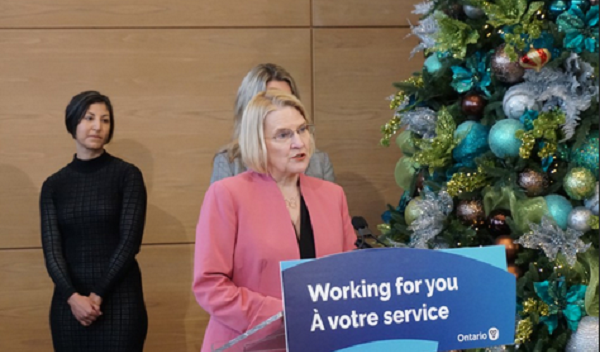Ontario planning to expand private clinics to address surgical backlogs
Ontario says it is moving ahead with its plan to expand the number of private clinics to tackle the province’s surgical wait lists, as its hospitals struggled with near-record wait times in emergency rooms.
The province’s Health Minister Sylvia Jones announced on Wednesday that this spring, her government would start the process of licensing new facilities where it intends to allow more outpatient procedures and tests to address lingering backlogs.
She also announced that Accreditation Canada, a non-profit that already accredits hospitals, would regulate both existing and new private-sector clinics, a job done now by the College of Physicians and Surgeons of Ontario.
The expansion of private clinics, announced a year ago and decried by critics as a move toward “two-tier” privatization, has already seen thousands of cataract eye surgeries moved out of hospitals, all funded by public-health insurance.
Ontario already has about 900 standalone, mostly private-sector clinics that largely do diagnostic tests. The government intends to allow more publicly funded procedures in such clinics this year, including magnetic-resonance imaging (MRI) scans, computerized tomography (CT) scans, endoscopies and even hip and knee replacements.
The announcement on Wednesday, at the offices of a Mississauga clinic, was made as many in the health care system warn that Ontario’s emergency rooms are in a crisis.
Blaming the winter season for viruses and “inadequate capacity in the health care system,” the Ontario Hospital Association, which speaks for hospital administrations, said that in November, the average length of stay in emergency departments (for patients waiting to be admitted) was the highest it has been in the last 12 months.
The OHA called this a “long-term, systemic problem,” owing to staffing shortages; high numbers of patients in hospitals awaiting discharge to other facilities, such as long-term care homes; and the fact that Ontario has fewer acute care beds than other jurisdictions.
According to numbers in a report from the government’s Ontario Health agency, obtained by The Globe and Mail, the average time patients remained in the ER before being admitted was 22.4 hours in November. Ten per cent of people who arrived in ERs in November and needed an inpatient bed waited at least 39.7 hours. All patients waited an average of 2.1 hours to see a doctor in the ER.
Ms. Jones said waits in emergency rooms “absolutely are concerning” but that the problem is “not a money investment conversation or challenge.” She said the issue was ensuring the system has enough staff across the province.
There was no word where, or how many, new private surgical or diagnostic clinics Ontario would allow. Ms. Jones said the government will expand in communities that have the highest wait times and highest needs.
Currently, only a small percentage of Ontario’s outpatient surgeries are done outside public hospitals. Alberta, Saskatchewan, B.C. and Quebec make more use of this kind of clinic, which is also common in the U.S.
NDP MPP Peter Tabuns said Wednesday that wait times in the province’s ERs were “out of control,” and that people in pain were being left to suffer.
He also dismissed the government’s plan to move more surgeries – still paid for by the health system – into private health clinics. He warned it would be the beginning of “two-tier” health care as new private-sector facilities drain staff and funding from public hospitals.
To fix ERs, the NDP has called for the government to cancel its legal appeal to revive legislation that limited public-sector wage hikes to 1 per cent, establish “safe” nurse-patient ratios, and crack down on the use of expensive private nursing agencies to fill staffing holes.
Liberal health critic Adil Shamji, a former Toronto emergency room doctor, urged the government to do more to retain scarce health care workers. He said Ms. Jones’s comments that the province’s ER crisis was “not a money” challenge were merely “damage control.”
Dr. Shamji said many hospitals were facing operating deficits, which he blamed on the cancellation of COVID-19 funding and the government’s failure to follow through on pledges to cover the costs of payments awarded to workers after a court struck down Ontario’s public-sector wage-cap law.
“The situation we are in here is a result of indifference, inaction and incompetence,” he said in an interview.
The Ontario Medical Association, which has supported the idea of clinics doing surgeries outside of hospital provided they are non-profits, released a plan this week to help shore up the health system. It urged the province to cut administrative burdens and do more to ensure all Ontarians have family doctors.
This article was reported by The Globe and Mail















